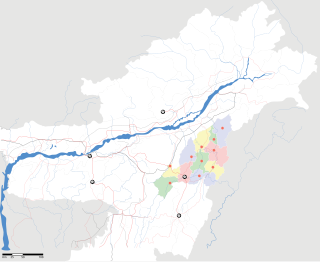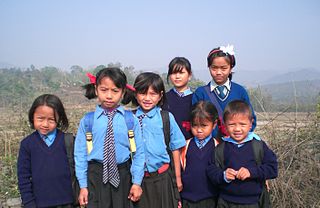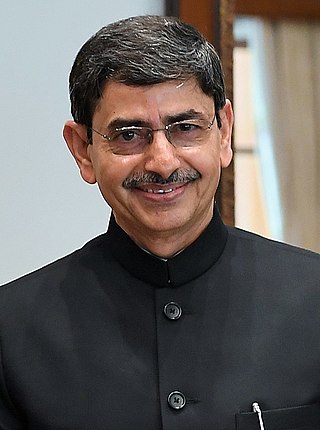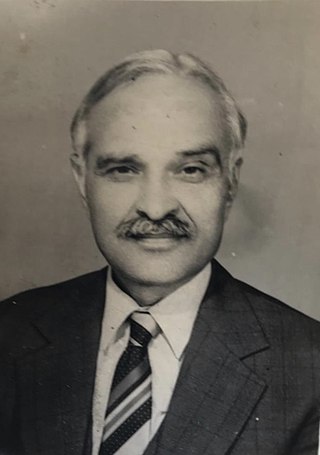Related Research Articles

The Insurgency in Northeast India involves multiple armed separatist factions operating in some of India's northeastern states, which are connected to the rest of India by the Siliguri Corridor, a strip of land as narrow as 14.29 miles (23.00 km) wide.

Senayangba Chubatoshi Jamir is an Indian politician and former Governor of Odisha. He was Parliamentary Secretary to Pandit Jawaharlal Nehru and Deputy Minister under Indira Gandhi. He has served as the Chief Minister of Nagaland, Governor of Maharashtra, Governor of Gujarat & Governor of Goa. He was awarded the third-highest Civilian Award in India, Padma Bhusan in 2020 for his work in public affairs.

The insurgency in Nagaland, in northeastern India, is an ongoing conflict fought between the ethnic Nagas and the governments of India. Nagaland inhabited by the Nagas is located at the tri-junction border of India on the West and South, north and Myanmar on the East.

The National Socialist Council of Nagaland (NSCN) is a Naga nationalist separatist group operating mainly in Northeast India, with minor activities in northwest Myanmar (Burma). The main aim of the organisation is to establish a sovereign Naga state, "Nagalim", which would consist of all the areas belonging to the Naga people in Northeast India and northwest Myanmar. The NSCN's slogan is "Nagaland for Christ".
The Naga National Council (NNC) is a political organization of Naga people, active from the late 1940s to the early 1950s. It evolved out of the Naga Hills District Tribal Council, an organization established in 1945 by the Deputy Commissioner of the Naga Hills district. The group was reorganized to form NNC in 1946 at Sanis, with Eno T. Aliba Imti Ao as the President, and other democratically elected Naga representatives as its members. Later, NNC declared Independence one day ahead of India i.e. on 14 August 1947.
Longri Ao (1906–1981), also known by name Longritangchetha, was an indigenenous Baptist missionary from the North-Eastern state of India, Nagaland. He was a missionary to the Konyak people and a peacemaker. He is known to have risked his life to restore peace in Nagaland, and to negotiate a ceasefire agreement between the Government of India and underground leaders fighting for Nagaland secession from India.
Thuingaleng Muivah is a Naga separatist politician and General Secretary of the National Socialist Council of Nagaland(I-M).
The Naga Peace Accord is a peace treaty, signed, on 3 August 2015, between the Government of India, and the National Socialist Council of Nagaland (NSCN), to end the insurgency in the state of Nagaland in Northeast India. The Government’s interlocutor for Naga Peace Talks, R. N. Ravi signed it on behalf of the Government of India, whereas Lt. Isak Chishi Swu, Chairman and Thuingaleng Muivah, General Secretary signed on behalf of the NSCN, in presence of the Indian Prime Minister, Narendra Modi.
Isak Chishi Swu was the chairman of the Nationalist Socialist Council of Nagaland (NSCN). He along with Thuingaleng Muivah and S. S. Khaplang were instrumental in the creation of NSCN on 31 January 1980 after opposing the ‘Shillong Accord’ signed by the then Naga National Council (NNC) with the Indian government. He was unable to attend the historic Naga Framework Agreement signed on 4 August 2015 due to health conditions.

Shangwang Shangyung Khaplang was a Burmese leader of Naga ethnicity. He was the leader of the NSCN-K, an insurgent group that operates to establish a Greater Nagaland, a sovereign state bringing all Naga-inhabited areas of Myanmar and India under one administrative setup.

The hill tribes of Northeast India are hill people, mostly classified as Scheduled Tribes (STs), who live in the Northeast India region. This region has the largest proportion of scheduled tribes in the country.

Ravindra Narayana Ravi is an Indian politician and former bureaucrat serving as the current and 15th Governor of Tamil Nadu. Ravi served as the 18th Governor of Nagaland from 1 August 2019 to 9 September 2021 and Governor of Meghalaya from 18 December 2019 to 26 January 2020.
Khodao Yanthan (1923–2010) was a Naga liberation leader and a member of the Naga National Council (NNC). He was popularly called, “the grand old man of Naga political struggle”.

The history of the Nagas dates back centuries, but first appear in written records of Ahom kingdom during the medieval period of Indian history. Aside from developing contacts with the Ahom kingdom, which was established in 1228 in Assam, the Nagas generally lived an isolated existence from the outside world. This changed in the 19th century, when the Burmese Empire launched several invasions of Assam between 1817 and 1826, which led the Nagas to briefly fall under Burmese rule. However, the neighboring British Empire annexed Assam in 1828 following the 1826 Treaty of Yandabo.
Elections to the Nagaland Legislative Assembly were held in February 1998 to elect members of the 60 constituencies in Nagaland, India. The Indian National Congress won a majority of the seats and S. C. Jamir was re-appointed as the Chief Minister of Nagaland. The number of constituencies was set as 60 by the recommendation of the Delimitation Commission of India.
Perietsü Tubu Kevichüsa was the General Secretary of Naga National Council who served until his assassination in June 1996 by armed men from the NSCN-IM. His brother Chalie Kevichüsa was also assassinated by the NSCN-IM in September 1992.

Manohar Lal Kampani was the first lieutenant governor of Andaman and Nicobar Islands. He served from 12 November 1982 to 3 December 1985.
This is a timeline of the history of the Nagas.
The Forum for Naga Reconciliation was formed in 2008 after the Naga Peace Convention organised by the Naga Shisha Hoho in Dimapur. At the start, it had 14 members. Wati Aier is the founding-convenor for the association. It has emerged as a major force in the Indo-Naga peace process outside the negotiation room between the Indian state and Naga nationalist groups.
References
- 1 2 3 4 5 6 7 8 "Nagaland Accord - The Shillong Agreement of November 11, 1975". satp.org/. Retrieved 27 April 2012.
representatives of the underground organisations met the Governor of Nagaland, Shri L.P. Singh representing the Government of India, at Shillong on 10th and 11th November, 1975.
- 1 2 3 4 5 6 "THE SHILLONG ACCORD OF 11 NOVEMBER 1975 BETWEEN THE GOVERNMENT OF INDIA AND THE UNDERGROUND NAGAS". npmhr.org. Retrieved 27 April 2012.
There was a series of four discussions. Some of the discussions were held with the Governor alone; at others, the Governor was assisted by the two Advisers for Nagaland, Shri Ramunny and Shri H. Zopianga, and Shri M.L. Kampani, Joint Secretary in the Ministry of Home Affairs. All the five members of the Liaison Committee namely Rev. Longri Ao, Dr. M. Aram, Shri L. Lungalang, Shri Kenneth Kerhuo and Shri Lungshim Shaiza, participated in the discussions.
- 1 2 3 4 5 6 7 "Dawn of Peace in Nagaland - SHILLONG ACCORD". nagaland.nic.in. Archived from the original on 14 March 2012. Retrieved 27 April 2012.
the historic "Shillong" signed at Shillong on November 11, 1975, by the Governor of Nagaland Mr. L.P Singh representing the Government of India and the underground leadership represented by Mr. Assa and Mr. Kevi Yalley
- 1 2 3 4 5 6 7 8 9 10 Reisang, Vashum (December 2000). Nagas' Rights to Self Determination. Mittal Publications. pp. 93–211. ISBN 9788170997740.
- 1 2 3 4 5 6 "The Peace Process in Nagaland". safhr.org. Retrieved 27 April 2012.
An Accord that never was: a critique of the 1975 Shillong Accord
- 1 2 3 4 5 6 "Nagaland: The Beginning of Insurgency - II : The Shillong Accord". indiandefencereview.com. 10 May 2011. Retrieved 22 January 2012.
The liaison committee held talks with Biesto Medom, Keviyalle (Phizo's brother), Ramyo and M Asa of the underground. When it became clear to the Governor, Shri LP Singh, that the agreement had a fair chance of success, he met the committee at Shillong. The Governor was assured that the underground on their own volition accepted without condition the Constitution of India and promised to deposit their arms at an appointed place. The agreement, which came to be called the Shillong Accord, was finally signed on November 11, 1975 - When the Shillong Accord was being negotiated, Isak Swu and Muivah with a group of 150 hardcore rebels were on their way back from China - When Muivah and Isak Swu were informed about the developments, they rejected the Accord and termed it as betrayal by the NNC and swore to fight on. - Soon cracks developed in the group. Isak and Muivah made derogatory remarks against Phizo and the policy adopted by the NNC.
- ↑ "SHILLONG ACCORD". nagaland.nic.in. Retrieved 29 January 2012.
JThe signing of the Shillong Accord had ushered in a general feeling of well-being all throughout and hope for peace and for a final solution of the twenty-year-old conflict once again appeared in the horizon.
- ↑ "Clarification on 'Shillong Accord'". nagalandpost.com. 23 October 2011. Retrieved 29 April 2012.
I say that in the name of Almighty God that the Naga National Council (NNC) never signed the Shillong Accord. Some of our leaders and I do have already clearly made known earlier about the signing of the Shillong Accord in 1975, that NNC was never a part of it. I therefore sincerely advise him to read once the text of Shillong Accord and not to repeat to write so in the near future, lest Mongaimo commits crime against the nation and it will be irreparable for him.
- ↑ Thomas, John (2016). Evangelising the Nation: Religion and the formation of Naga Political Identity (First ed.). New Delhi: Routledge. p. 176. ISBN 9781138639928.
- ↑ "Naga solution: 'Supra state' may don new avatar". sevensisterspost.com. Archived from the original on 28 April 2012. Retrieved 28 April 2012.
NSCN-IM general secretary Thuingaleng Muivah and chairman Isak Chishi Swu are in Delhi for another round of talks with the Government of India.
{{cite web}}: CS1 maint: unfit URL (link) - ↑ "NNC slams Shillong Accord". The Times of India . 30 May 2011. Archived from the original on 1 July 2012. Retrieved 28 April 2012.
Naga National Council (NNC), led by Senka Yaden, reiterated that it was against the Shillong Accord and added that it would not budge an inch from its demand for Naga sovereignty - "Naga sovereignty is our birthright. We shall never compromise on this," NNC vice-president Kiumukam Yimchunger